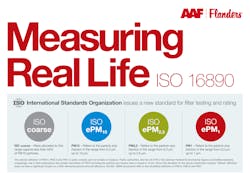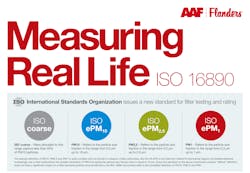4 Factors for Good Indoor Air Quality
by Matthew Dodds and Jerry McGuire
Find chart download at end of article
Imagine walking into a friend’s home or an employer’s office, turning on the sink faucet, and instead of clean water, sludge drips out. It’s tough to envision anyone heartily gulping down a glass of this brew, let alone taking the tiniest of sips. And that makes sense – if you can see and smell the warning signs of unsafe or unsavory drinking water, why drink it?But what about the air people breathe, particularly the indoor air? Indoor air quality (IAQ) is the barometer of health for the inside of a space and encapsulates all conditions related to quality of human life and experience within a closed area, as influenced by the air.People spend more than 90 percent of their time indoors, but often pay little attention to the quality of air within a building’s four walls, walking unknowingly into spaces that could be negatively impacting their health and productivity. And to be clear, IAQ is impacting health: poor IAQ ranks as one of the top five environmental risks to public health, with pollution levels indoors being up to five times higher than outdoors, according to the U.S. Environmental Protection Agency (EPA).Experts in the business tend to think of IAQ on a spectrum of positive to poor. “Positive” means air contributes to the health and productivity of the people who inhabit the space and “poor” is the antithesis of that – air that actively reduces productivity levels in employees and harms the health and wellness of individuals. The reason it’s often overlooked is largely due to the fact that seeing “good” versus “bad” air quality is nearly impossible to the naked eye. Luckily, building owners and regulators are taking notice of the impact air quality has, and are helping drive changes in IAQ management to support improved health and wellness.Here are four factors commercial and residential HVAC contractors alike should consider, to ensure they’re maintaining positive IAQ. After all, clean indoor air is the new clean water:Thermal ComfortOne of the most obvious components of IAQ is thermal comfort. Adjusting the thermostat is the de facto “go-to” when individuals aim to modulate IAQ. Introducing dry, fresh air can be a significant challenge when reaching precise temperature goals. For two residence halls at Bethel University in St. Paul, Minn., Daikin Applied swapped its existing fan coils for Rebel rooftop units. These units introduced fresh air utilizing energy recovery wheels, and are 60 percent more efficient at removing moisture from the air, which helped the 52,750 sq. ft. complex stay below its 55 percent humidity goal. And while thermal comfort is important for building occupants, it’s really just the tip of the iceberg when it comes to managing IAQ. Air FiltrationThe top cause of poor IAQ is lack of proper air filtration. The World Health Organization has provided recommended standards covering three ranges of particle sizes, specifying guidelines for acceptable particulate matter concentrations. The human eye can only see particles as small as 25 to 60 microns – or the diameter of a human hair – but the particles that are most dangerous to human health are significantly smaller and invisible to the human eye (PM 2.5 and PM 1). Proper filtration can remove these dangerous particulates from the air, reducing the potential for negative health impacts. To help identify what adjustments are needed to optimize IAQ.AFF Flanders has developed a new app-driven HVAC sensor technilogy — Sensor360™ — that tells building managers precise particulate concentration levels they have outside and inside their buildings, to keep a true pulse on the quality of air inside a space. VentilationJust like humans, buildings breathe with their occupants. When humans occupy an enclosed space, oxygen is consumed and CO2 is generated. Buildings need to introduce new, fresh air into the space to keep CO2 levels within healthy ranges for the breathing occupants. Monitoring and controlling the introduction of fresh air to buildings is critical to good IAQ.Building PressureIf you’ve ever walked up to a building to open the door and it stands open — or you can’t open it because it’s too difficult to pull — you’ve experienced poor building pressure control. In overly pressured buildings, poor controls, leaky dampers and modulating airflows are causing HVAC systems to introduce more fresh ventilation air than they can exhaust. Fortunately, with the proper controls schemes, dampers can be reset and modulated proportional to supply fan airflows and today’s HVAC equipment can precisely control outdoor air flow quantities when equipped with low leak dampers, CO2 sensors and outdoor air flow monitors. These technologies all help prevent over and under pressurization and promote positive IAQ. Maintaining a slightly positive pressure helps a building’s HVAC system function in an ideal state, minimizing waste and optimizing comfort.As humans continue to spend the vast majority of the day indoors, it’s imperative that indoor air quality be top of mind for building managers and homeowners alike, to keep occupants safe, healthy and productive.
Matthew Dodds is product product manager, applied rooftops systems for Daikin Applied. Jerry McGuire is vice president, global marketing, AAF Flanders.

